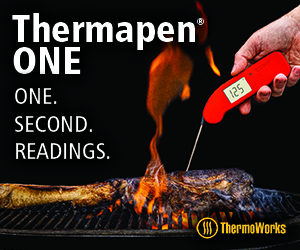Summary
- Buy a 5-7 pound boneless leg of lamb with the sirloin muscle removed.
- Separate the leg into three pieces along natural lines of fat and connective tissue.
- Trim meat extensively to remove fat, gristle, and silver skin, reserving meaty scraps for accompanying jus.
- Brine the meat for 2 hours.
- Prepare a roasted garlic/parsley paste and roasted garlic jus while the meat brines.
- Apply paste to each piece of meat and tie into a small roast shape.
- Just before cooking, sprinkle with kosher salt and freshly ground black pepper.
- Cook at 350-400°F until 120°F for medium-rare, 125°F for medium, 130°F for medium-well, approximately 30-40 minutes.
- Place cooking grate directly over hot coals. Sear roasts on all four sides, approximately 2 minutes per side.
- Tent with foil and let rest for 10 minutes before slicing.
- Serve with roasted garlic jus.

This approach to cooking lamb on the Weber Smokey Mountain Cooker has been adapted from the article “Rethinking Roasted Leg of Lamb” in the March/April 2006 issue of Cook’s Illustrated magazine.
The recipe calls for a boneless leg of domestic lamb with the sirloin muscle removed. When I talked to my lamb purveyor, he referred to this a “short leg of lamb”. Since terminology may differ from one butcher to the next, your best bet is to ask for a “whole, boneless leg of lamb with the sirloin muscle removed”. Do not buy a butterflied leg of lamb for this recipe.
The use of domestic lamb, combined with extensive trimming of fat, results in a finished product with very mild flavor that is not at all gamy.
Be prepared to spend 60 minutes or more breaking down the boneless leg of lamb into three separate pieces, trimming all areas of surface fat, internal fat, silver skin and gristle, scoring the meat, and prepping the scrap meat for use in the garlic jus. I would recommend that you prep the meat the night before, then brine, tie, and cook the meat the next day.
Here’s a description and photos of how I cooked this recipe on March 18, 2006.
Select And Trim The Lamb

Choose a 5-7 pound boneless leg of domestic lamb with the sirloin muscle removed. The one shown here is a 5 pound, 4-3/4 ounce leg of California lamb from CK Lamb in Healdsburg, CA.
Most boneless legs of lamb will be netted like the one shown here. Remove the netting and unroll the meat in order to do some extensive trimming of fat and gristle.


Here are the steps for trimming the meat. Take your time and work carefully, using a sharp boning knife.
- Separate the leg into three pieces following the natural seams of fat and connective tissue.
- Trim all visible surface fat, gristle, and silver skin from each piece.
- Using small, shallow cuts, remove any deep pockets of fat and gristle.
- While trimming, reserve any large, meaty scraps for the roasted garlic jus.
- Score the inside of each piece with 1/4″ deep cuts in a 1″ diamond pattern.
This photo shows the three pieces after trimming and the reserved meaty scraps (at top). Note that this photo does not show the discarded fat, gristle, etc.

This photo shows the scoring on the inside of one piece.

Now turn your attention to the meaty scraps. As with the three pieces, remove all fat, gristle, and silver skin. Cut into 1″ pieces. You should end up with 3/4 to 1-1/2 cups of trimmed scraps.

If you wish, you can stop at this point, put the meat in the refrigerator overnight, and finish the recipe the next day.
Brine The Lamb
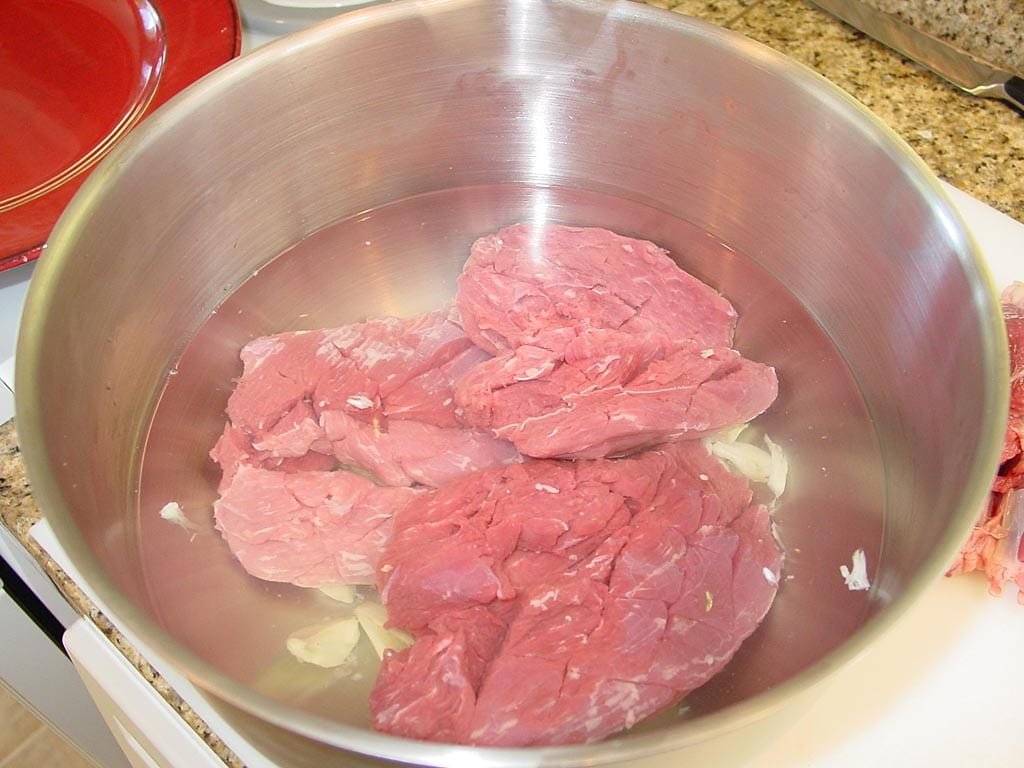 Brine the three pieces of lamb for 2 hours in the refrigerator using this recipe. Brining adds flavor to the meat and helps improve its texture, making it seem more tender.
Brine the three pieces of lamb for 2 hours in the refrigerator using this recipe. Brining adds flavor to the meat and helps improve its texture, making it seem more tender.
Garlic Brine For Lamb
- 2 quarts cold water
- 1/4 cup Diamond Crystal Kosher Salt
- 1/4 cup sugar
- 12 medium garlic cloves, crushed
Combine ingredients in a non-reactive container, mixing thoroughly to dissolve salt and sugar. Substitute 3 Tablespoons Morton Kosher Salt or 2 Tablespoons table salt for Diamond Crystal.
While the lamb is brining, prepare the roasted garlic & parsley paste and the roasted garlic jus.
Prepare The Roasted Garlic & Parsley Paste
You will need the following ingredients for the paste:
Roasted Garlic & Parsley Paste
- 2 medium garlic heads
- 1 Tablespoon olive oil
- 2 Tablespoons minced fresh parsley leaves
Preheat the oven to 400°F.
Remove the papery outer skins from each garlic head and cut off the top 1/3 to expose the cloves inside. Place the garlic cut-side up on a sheet of aluminum foil. Drizzle with olive oil and wrap the foil tightly around the garlic to form a pouch.
Place the pouch on a rimmed baking sheet pan and bake for 40-45 minutes or until the cloves are very soft and golden brown. I roasted three heads…you can never have too much roasted garlic around!
Let the garlic cool until it can be handled safely, then squeeze out the soft insides. Use the side of a chef’s knife to mash the cloves into a smooth paste.
In a bowl, combine 2 Tablespoons of garlic paste with the parsley and mix thoroughly. Reserve 2 Tablespoons of the remaining paste for the roasted garlic jus.
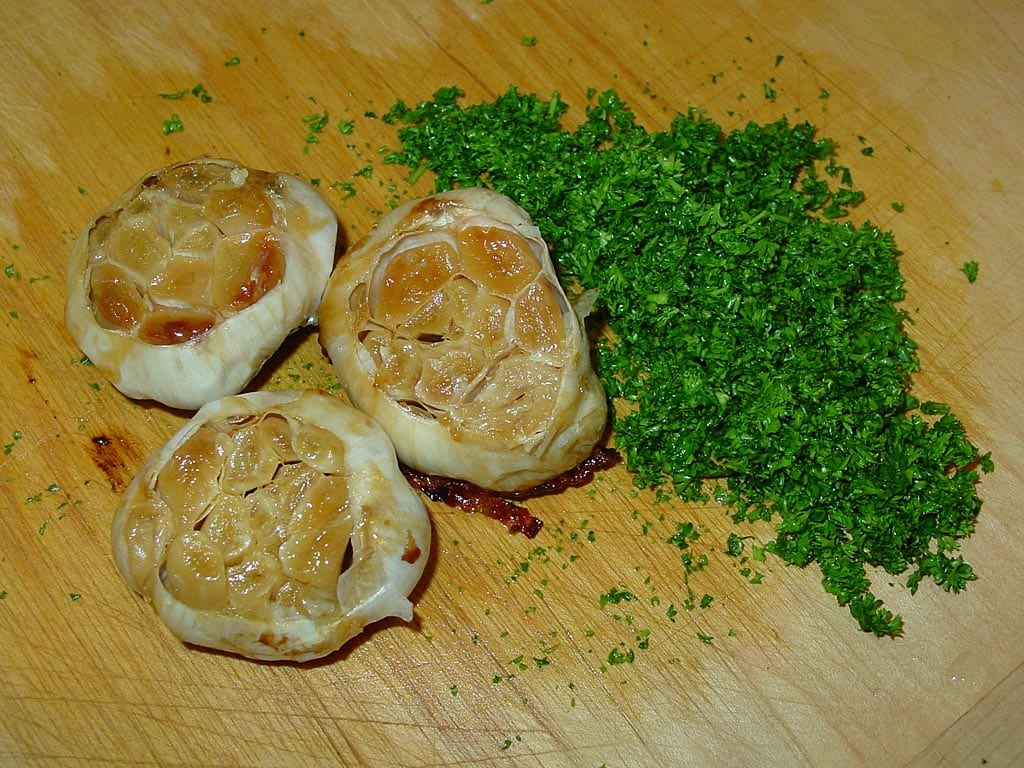

Prepare The Roasted Garlic Jus
You will need the following ingredients for the jus:
Roasted Garlic Jus
- 1 Tablespoon vegetable oil
- 3/4 to 1-1/2 cups lamb scraps, trimmed of all fat, cut into 1″ pieces
- 1 medium yellow onion, diced large, about 1-1/2 cups
- 1/2 cup dry white wine, e.g. Chardonnay
- 4 cups low-sodium chicken broth
- 2 Tablespoons roasted garlic paste
- 1 teaspoon red wine vinegar
Heat the vegetable oil in a Dutch oven over medium-high heat until shimmering. Add the lamb and onions, stirring occasionally and cooking until the lamb is browned and the onions are soft and golden, about 8-10 minutes (reduce the heat to medium if the browned bits in the bottom of the pan start getting very dark).
Add wine and simmer about 1 minute. Scrape the bottom of the pan to loosen the browned bits. Stir in broth and garlic paste. Simmer until reduced by half, about 15-20 minutes. Strain the jus through a fine-mesh strainer into a small saucepan and discard the solids. Add vinegar. Cover and keep warm until served.
Apply Paste & Tie The Lamb
Remove the lamb from the brine. Do not rinse the meat, just pat it dry thoroughly with paper towels.
Spread paste on the scored side of the lamb, making sure to get it into the cuts.
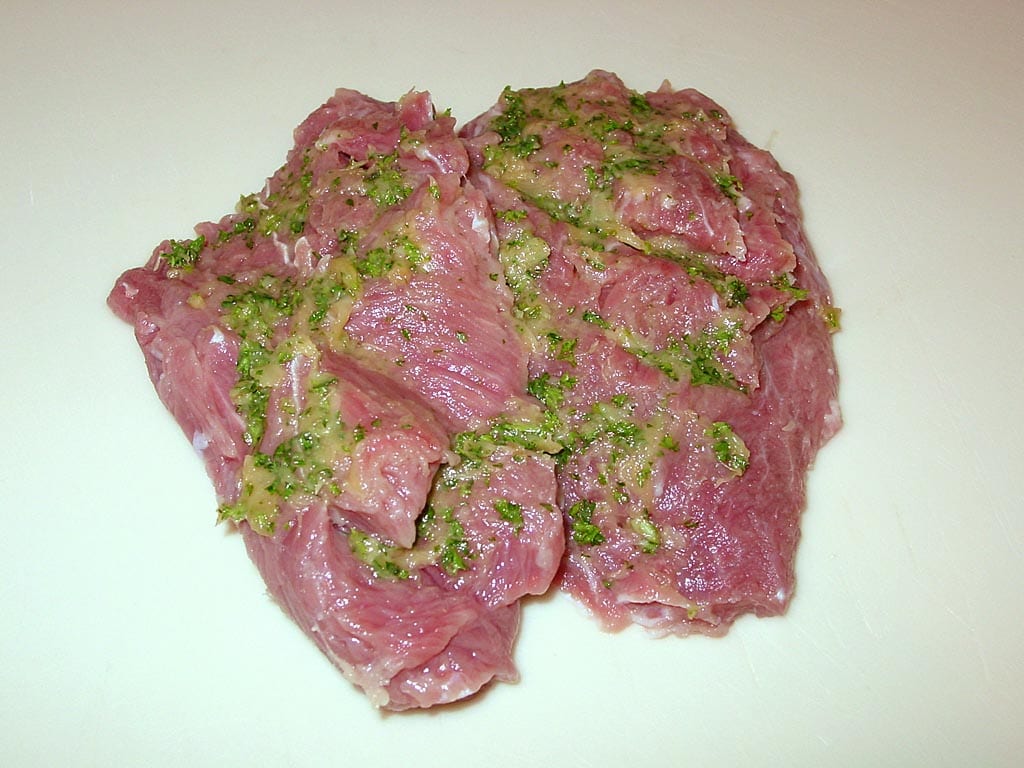
Here are the steps for tying the lamb. Tying keeps the paste inside the meat and creates a small roast shape. For a lesson in tying knots, watch the How To Tie A Roast video.
- Pre-cut 15 pieces of kitchen twine, each about 12″ long.
- Roll the meat lengthwise into a compact shape, making sure to tuck in any loose bits.
- Tie at 1″ intervals in 5 locations.
- Trim the loose ends of the twine.
Here’s how one of the roasts looked when tied.
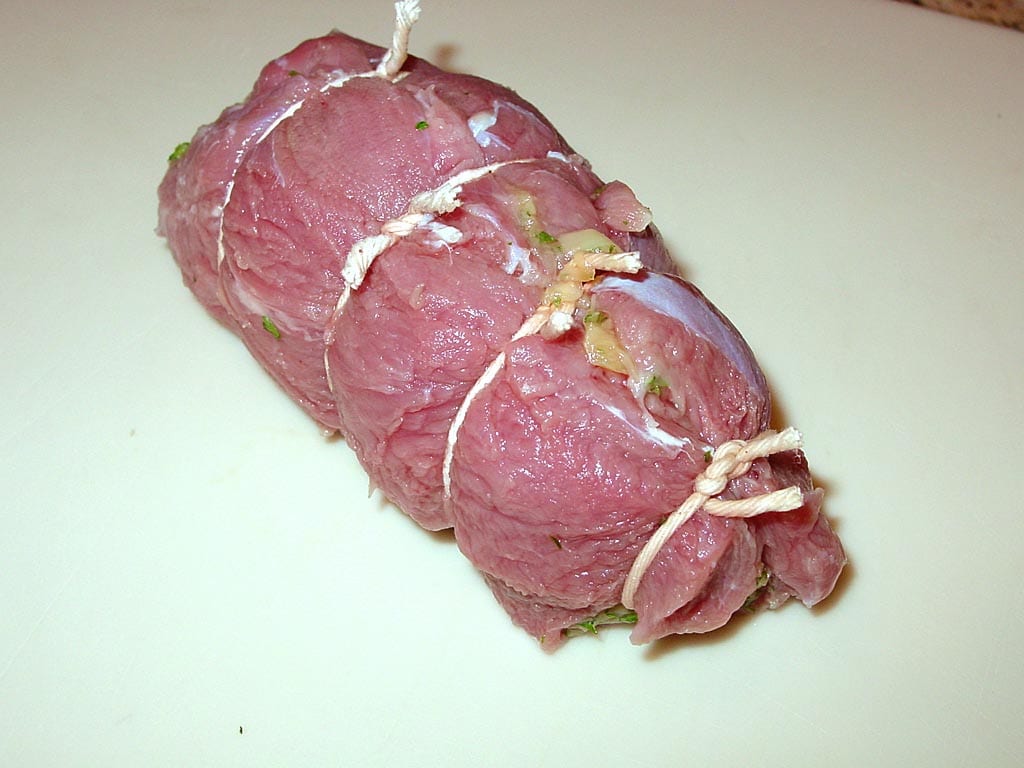
Just before cooking, season each roast with kosher salt and freshly ground black pepper on all surfaces.
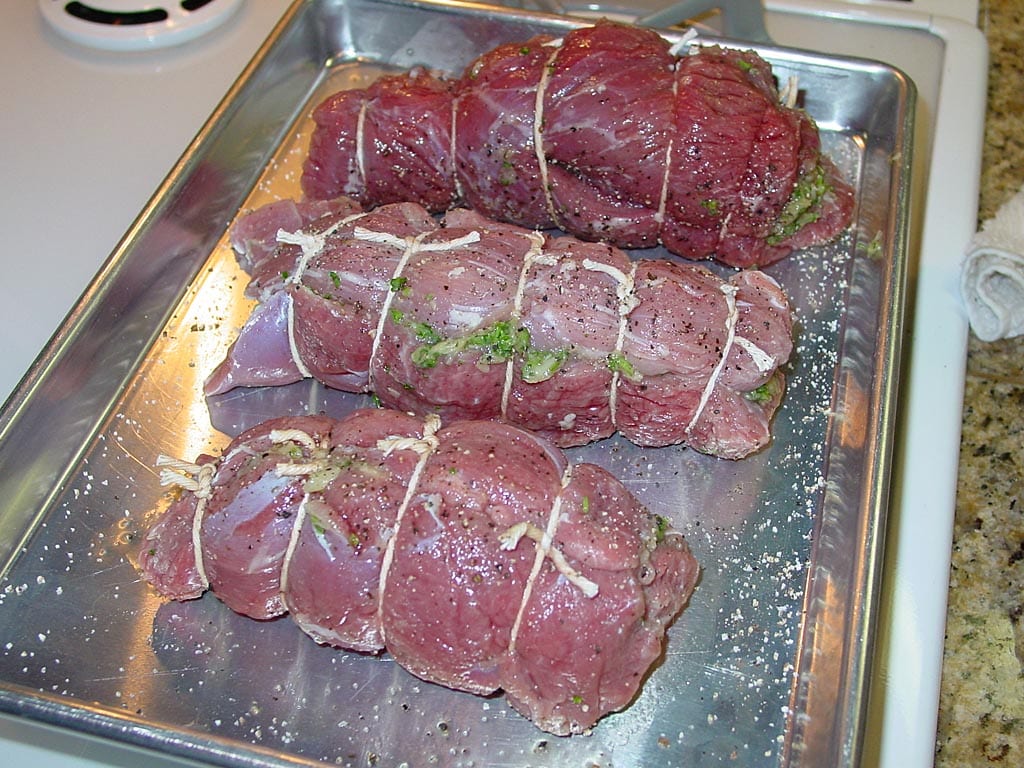
Fire The WSM
Fire-up the cooker using the Standard Method—one full Weber chimney starter of hot Kingsford Charcoal Briquets in the charcoal bowl, followed by another full chimney of unlit Kingsford, allowing all coals to become fully lit before cooking. If you have two chimneys, you can fire both simultaneously.
Foil The Water Pan
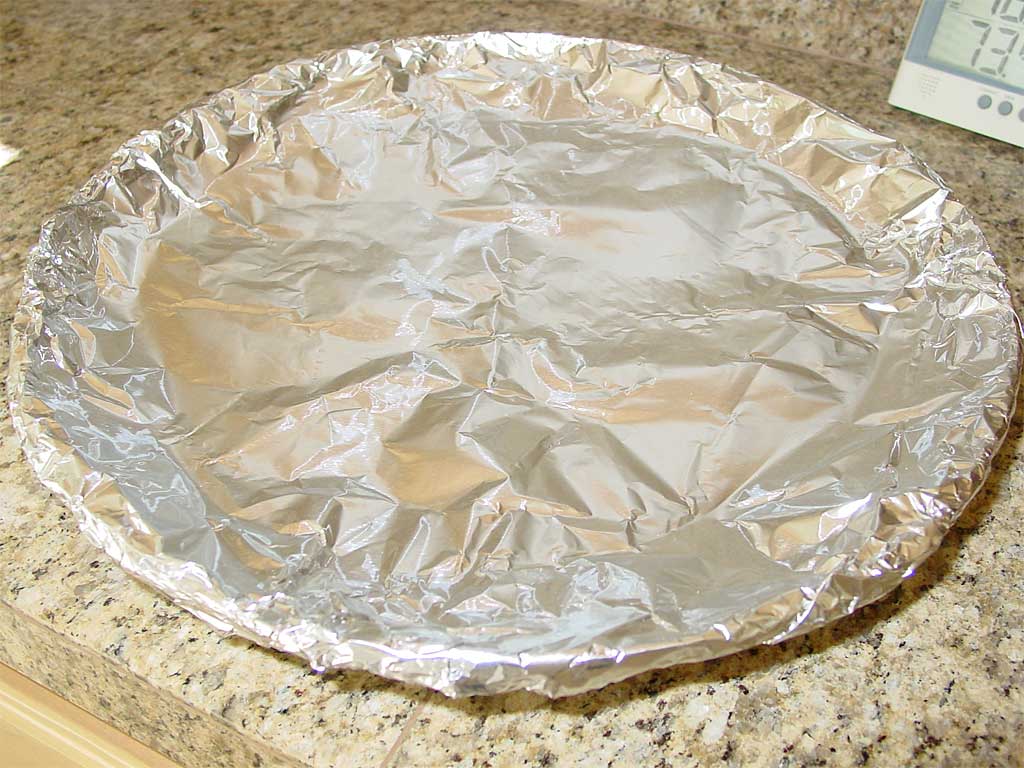 Cover the inside and outside of the water pan with wide, heavy duty aluminum foil. Place the pan inside the cooker, but leave it empty.
Cover the inside and outside of the water pan with wide, heavy duty aluminum foil. Place the pan inside the cooker, but leave it empty.
Smoke The Lamb
 Place 1-2 small chunks of dry smoke wood on the coals. I used 2 chunks of oak wood, maybe equivalent to a single fist-sized chunk.
Place 1-2 small chunks of dry smoke wood on the coals. I used 2 chunks of oak wood, maybe equivalent to a single fist-sized chunk.
Assemble the cooker and place the lamb roasts on the top grate. Set the top vent and three bottom vents to 100% open and leave them that way throughout the entire cook.
Let the cooker run as hot as it wants to, in the 350-400°F range.
Cook the lamb to an internal temperature of 120°F for medium-rare, 125°F for medium, 130°F for medium-well, approximately 30-40 minutes. Start checking the internal temp after about 20 minutes with an instant-read thermometer.
There’s no need to baste or rotate the lamb during the cooking process.
Here’s how the cooker temperatures and vent settings went during my cook:
| Time | Lid Temp | Meat Temp | Vent 1 % | Vent 2 % | Vent 3 % |
| 6:50 pm | 380 | – | 100 | 100 | 100 |
| 7:00 pm | 365 | – | 100 | 100 | 100 |
| 7:15 pm | 367 | – | 100 | 100 | 100 |
| 7:20 pm | 365 | 129-133 (a) | 100 | 100 | 100 |
| 7:30 pm | 378 | 129-133 (b) | 100 | 100 | 100 |
(a) Two smaller roasts done.
(b) One larger roast done.
Note that the vent percentages represent the way I set the vents at the time indicated.
Due to differences in size, the roasts may finish cooking at different times, so remove them from the cooker to a plate as each one is done. Check the internal temperature in several locations and average the results to determine doneness.
Notice that in my cook, two of the roasts reached about 130°F after 30 minutes of cooking, while the third larger roast cooked an additional 10 minutes.
Sear The Lamb
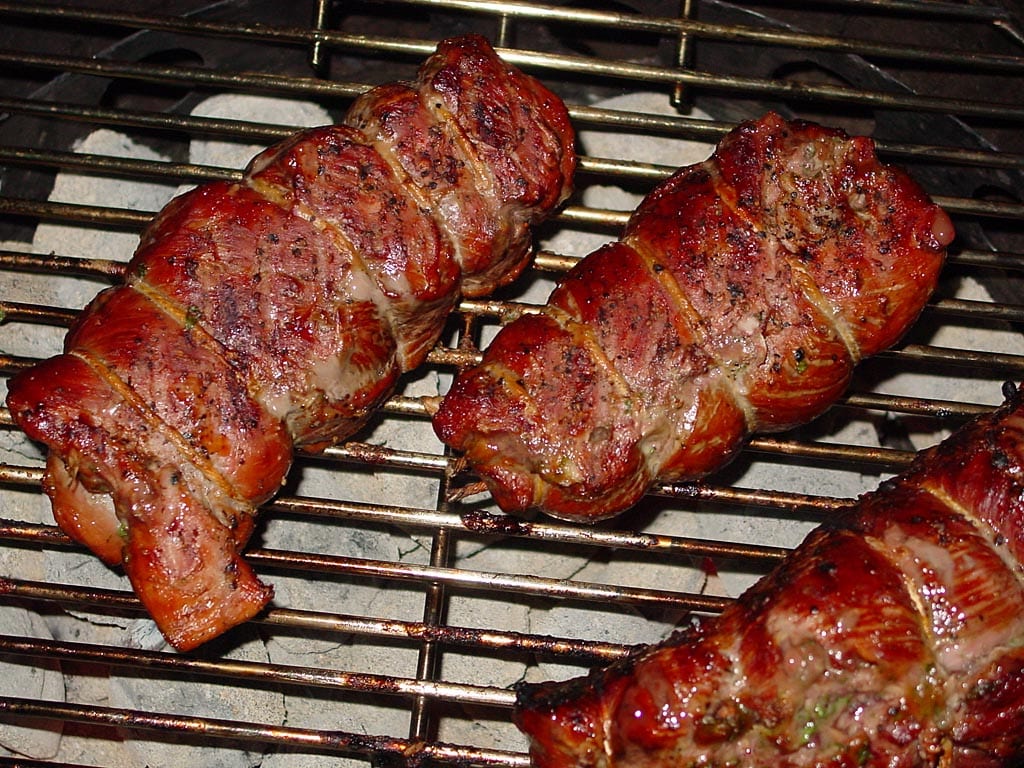 Searing the lamb at the end of cooking, also known as reverse searing, adds great flavor and color to the meat.
Searing the lamb at the end of cooking, also known as reverse searing, adds great flavor and color to the meat.
Remove the top cooking grate from the cooker and set it aside. Lift off the middle cooking section and set it aside. Use tongs to evenly spread out the hot coals in the charcoal chamber, if necessary.
Place the cooking grate directly on top of the charcoal chamber. Sear the lamb roasts on all four sides, approximately 2 minutes per side or until browned to your liking.
You’ll have lots of hot coals leftover after searing the lamb, so consider putting that fire to good use by grilling additional meat, veggies, or maybe a dessert.
Rest Then Slice The Lamb
Remove the lamb from the hot coals to a plate. Tent with foil and let rest for 10 minutes before slicing.
Snip the kitchen twine and remove it. Slice the meat into 1/4″ slices. Pour any accumulated juices from the plate into the jus and stir. Arrange slices on a plate and spoon on some of the jus.
This photo shows the seared lamb after a 15 minute rest, cooked to medium doneness.

This photo shows the lamb and roasted garlic jus plated with rice pilaf and mixed vegetables.

I wrote in my cooking log that the meat had a dark, mahogany-colored exterior and was very moist and tender inside with a small smoke ring. The flavor was milder than beef, but stronger than pork tenderloin, and not at all gamy. It had a pronounced garlic flavor that garlic lovers will enjoy, but even those who are sensitive to garlic will not find it objectionable.






